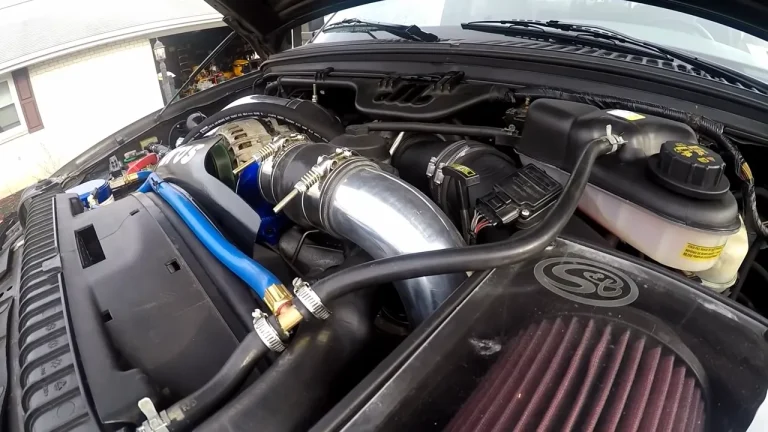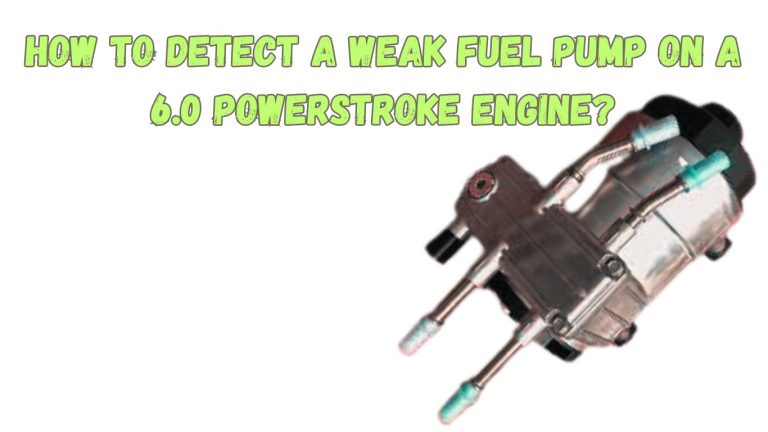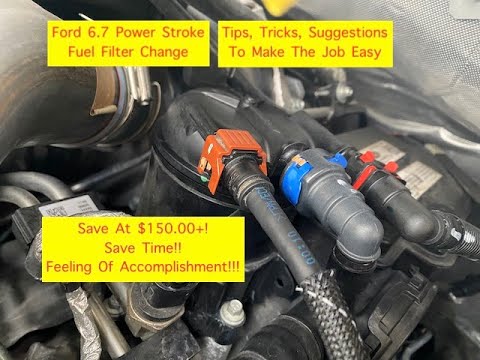7.3 Exhaust Back Pressure Sensor Symptoms: Identifying Potential Issues
The 7.3-liter Powerstroke engine has been renowned for its robust performance and reliability. However, like any mechanical system, it is susceptible to various issues that can affect its optimal functioning. One common component in the 7.3 Powerstroke engine that can cause performance problems is the exhaust back pressure sensor.
The exhaust back pressure sensor plays a crucial role in monitoring the pressure levels in the exhaust system. It helps the engine management system make necessary adjustments for optimal engine performance and emission control. When this sensor malfunctions or experiences issues, it can lead to a range of symptoms that can affect the engine’s overall performance.
In this blog post, we will delve into the symptoms that may indicate problems with the exhaust back pressure sensor in a 7.3 Powerstroke engine. From reduced power and poor fuel efficiency to excessive smoke emissions and engine misfires, we will explore the telltale signs that may point to a faulty or failing sensor.
By understanding these symptoms, you will be better equipped to identify potential issues and take appropriate action to rectify them. Whether it involves sensor cleaning, replacement, or seeking professional assistance, our aim is to provide you with valuable insights and solutions to keep your 7.3 Powerstroke engine running smoothly.
Symptoms Of A Bad 7.3 Exhaust Back Pressure Sensor
When the exhaust back pressure sensor in a 7.3 Powerstroke engine starts to malfunction or fails completely, it can manifest through various symptoms. These symptoms can indicate potential issues with the sensor and may require attention and repairs. Here are some common signs of a bad 7.3 exhaust back pressure sensor:
1. Reduced Engine Power
A faulty exhaust back pressure sensor can cause a decrease in engine power and overall performance. You may notice a lack of acceleration, sluggishness, or difficulty maintaining speed, especially during heavy loads or uphill driving.
2. Poor Fuel Efficiency
The sensor helps the engine management system optimize fuel delivery based on exhaust pressure readings. When the sensor is faulty, it can lead to inaccurate fuel calculations, resulting in poor fuel efficiency and increased fuel consumption.
3. Excessive Smoke Emissions
A failing exhaust back pressure sensor can disrupt the air-fuel mixture and affect combustion efficiency. This can lead to abnormal smoke emissions, such as excessive black smoke from the exhaust, indicating a rich fuel mixture.
4. Engine Misfires
The sensor plays a role in monitoring and adjusting the air-fuel mixture for proper combustion. If the sensor provides incorrect readings, it can result in an imbalanced mixture, leading to engine misfires, rough idling, or irregular engine operation.
5. Check Engine Light
A malfunctioning exhaust back pressure sensor can trigger the check engine light (CEL) on the dashboard. The CEL serves as a warning that the engine management system has detected a problem, and retrieving the specific error codes can help pinpoint the issue.
6. Reduced Exhaust Brake Performance
In some cases, a failing exhaust back pressure sensor can affect the operation of the exhaust brake system. You may experience a decrease in the effectiveness of the exhaust brake when braking or towing heavy loads.
What To Do When You Detect A Bad 7.3 Exhaust Back Pressure Sensor?
When you detect a bad 7.3 exhaust back pressure sensor, it’s important to take appropriate steps to address the issue and restore proper functioning of your engine. Here’s what you should do:
Confirm the Diagnosis
If you suspect a faulty exhaust back pressure sensor based on the symptoms you’re experiencing, it’s a good idea to confirm the diagnosis. Consult a qualified mechanic or diesel specialist who can perform diagnostic tests and use specialized equipment to pinpoint the issue. They will be able to verify if the sensor is indeed the cause of the problem.
Replace the Sensor
If the exhaust back pressure sensor is diagnosed as the culprit, the recommended course of action is to replace the sensor. The faulty sensor should be carefully removed, and a new, high-quality replacement sensor should be installed. It’s advisable to use OEM (Original Equipment Manufacturer) or reputable aftermarket parts to ensure compatibility and reliable performance.
Reset the Engine Management System
After installing the new sensor, it’s important to reset the engine management system. This can be done using a diagnostic scanner or by disconnecting the battery for a few minutes. Resetting the system will clear any stored error codes and allow the engine management system to recalibrate with the new sensor.
Test and Verify Performance
Once the sensor replacement and system reset are complete, it’s crucial to test the vehicle and verify that the symptoms have been resolved. Take the vehicle for a drive, paying attention to engine power, fuel efficiency, exhaust emissions, and overall performance. If the symptoms persist, it may indicate additional issues that need to be addressed.
Seek Professional Help
If you’re unsure about performing the diagnosis and replacement yourself, or if the symptoms persist after replacement, it’s advisable to seek professional help. A qualified mechanic or diesel specialist will have the expertise and specialized tools to accurately diagnose and resolve the issue.
Is Replacing A Bad 7.3 Exhaust Back Pressure Sensor Expensive?
The cost of replacing a bad 7.3 exhaust back pressure sensor can vary depending on several factors, including the brand of the sensor, labor costs, and the specific repair shop you choose. Here are some considerations that may affect the cost:
1. Brand and Quality
The cost of the replacement sensor can vary depending on the brand and quality. OEM (Original Equipment Manufacturer) sensors are typically more expensive compared to aftermarket options. However, OEM sensors often offer better compatibility and reliability.
2. Labor Costs
The labor costs associated with replacing the exhaust back pressure sensor will depend on the complexity of the job and the hourly rates of the repair shop. Some sensors may be more accessible and easier to replace, while others may require more extensive disassembly.
3. Additional Repairs
In some cases, other components or gaskets may need to be replaced along with the sensor. This can add to the overall cost of the repair. For example, if the sensor is located in a challenging location and requires disassembly of other components, additional labor charges may apply.
4. DIY vs. Professional Repairs
If you have the necessary skills and tools, you may choose to replace the sensor yourself, which can save on labor costs. However, it’s important to consider your comfort level and experience with automotive repairs. If you’re uncertain or inexperienced, it’s recommended to seek professional help to ensure proper installation and avoid potential complications.
Given these factors, the cost of replacing a bad 7.3 exhaust back pressure sensor can range from around $100 to $300 or more. It’s advisable to consult with a trusted mechanic or diesel specialist who can provide an accurate estimate based on your specific situation.
While the cost of replacement may vary, it’s important to address a bad exhaust back pressure sensor promptly. Ignoring or delaying the repair can lead to further engine performance issues, decreased fuel efficiency, and potential damage to other components. By addressing the problem in a timely manner, you can restore optimal engine function and potentially avoid more expensive repairs down the line.
How Often Should You Service The 7.3 Exhaust Back Pressure Sensor?
Servicing the 7.3 exhaust back pressure sensor does not typically require routine maintenance. The sensor itself is a component that is designed to be durable and reliable for an extended period. However, there are certain situations where it may be necessary to service or inspect the exhaust back pressure sensor. Here are some considerations:
- Symptoms of Malfunction: If you experience symptoms such as reduced engine power, poor fuel efficiency, excessive smoke emissions, or engine misfires, it may indicate a problem with the exhaust back pressure sensor. In such cases, it is important to have the sensor inspected and, if necessary, serviced or replaced.
- Other Engine Maintenance: During routine maintenance or repairs on other engine components, it may be opportune to inspect the condition of the exhaust back pressure sensor. For example, if you are replacing the exhaust system, turbocharger, or other related components, it may be a good time to check the sensor as well.
- Sensor Age and Mileage: While there is no specific service interval for the exhaust back pressure sensor, it is worth considering the age and mileage of the vehicle. If your 7.3 Powerstroke engine is older or has high mileage, it may be prudent to inspect the sensor during major service intervals or when other engine maintenance is performed.
- Diagnostic Testing: If you are experiencing issues with the engine’s performance or suspect a problem with the exhaust back pressure sensor, diagnostic testing can help determine the cause. A qualified mechanic or diesel specialist can use specialized diagnostic equipment to test the sensor’s functionality and make any necessary adjustments or replacements.
FAQ:
Q1: What are the symptoms of a bad exhaust back pressure sensor in a 7.3 Powerstroke engine?
A: Symptoms of a bad exhaust back pressure sensor in a 7.3 Powerstroke engine can include reduced engine power, poor fuel efficiency, excessive smoke emissions, engine misfires, and the illumination of the check engine light. These symptoms may vary in severity depending on the extent of the sensor’s malfunction.
Q2: Can a bad exhaust back pressure sensor cause engine stalling or rough idling?
A: Yes, a malfunctioning or failed exhaust back pressure sensor can contribute to engine stalling or rough idling. Since the sensor plays a role in optimizing the air-fuel mixture and combustion process, its improper readings can lead to irregular engine operation and unstable idling.
Q3: How can I confirm if the exhaust back pressure sensor is the cause of the symptoms in my 7.3 Powerstroke engine?
A: To confirm if the exhaust back pressure sensor is the cause, it is recommended to consult a qualified mechanic or diesel specialist. They can use diagnostic tools to read the sensor’s data and compare it to expected values. Additionally, they can perform further tests to rule out other potential issues.
Q4: Can I drive my 7.3 Powerstroke with a faulty exhaust back pressure sensor?
A: While it is possible to drive with a faulty exhaust back pressure sensor, it is not advisable. The sensor’s malfunction can lead to decreased engine performance, compromised fuel efficiency, and potential damage to other engine components. It is best to address the issue promptly to ensure proper engine operation.
Q5: Can I replace the exhaust back pressure sensor myself, or should I seek professional help?
A: The replacement of the exhaust back pressure sensor can be performed by experienced DIY enthusiasts, provided they have the necessary knowledge and tools. However, it is recommended to seek professional help if you are uncertain or inexperienced, as improper installation can lead to further complications.
Q6: How much does it cost to replace a bad exhaust back pressure sensor in a 7.3 Powerstroke engine?
A: The cost of replacing the exhaust back pressure sensor can vary depending on factors such as the brand of the sensor, labor costs, and location. Generally, the cost can range from around $100 to $300 or more. It is advisable to consult a qualified mechanic for an accurate estimate based on your specific situation.
Q7: How often should I inspect or service the exhaust back pressure sensor in my 7.3 Powerstroke engine?
A: The exhaust back pressure sensor does not typically require routine maintenance. However, if you experience symptoms or perform major engine maintenance, it may be a good opportunity to inspect the sensor. Refer to the vehicle’s owner manual or consult a professional for specific guidance based on your vehicle’s age and mileage.



